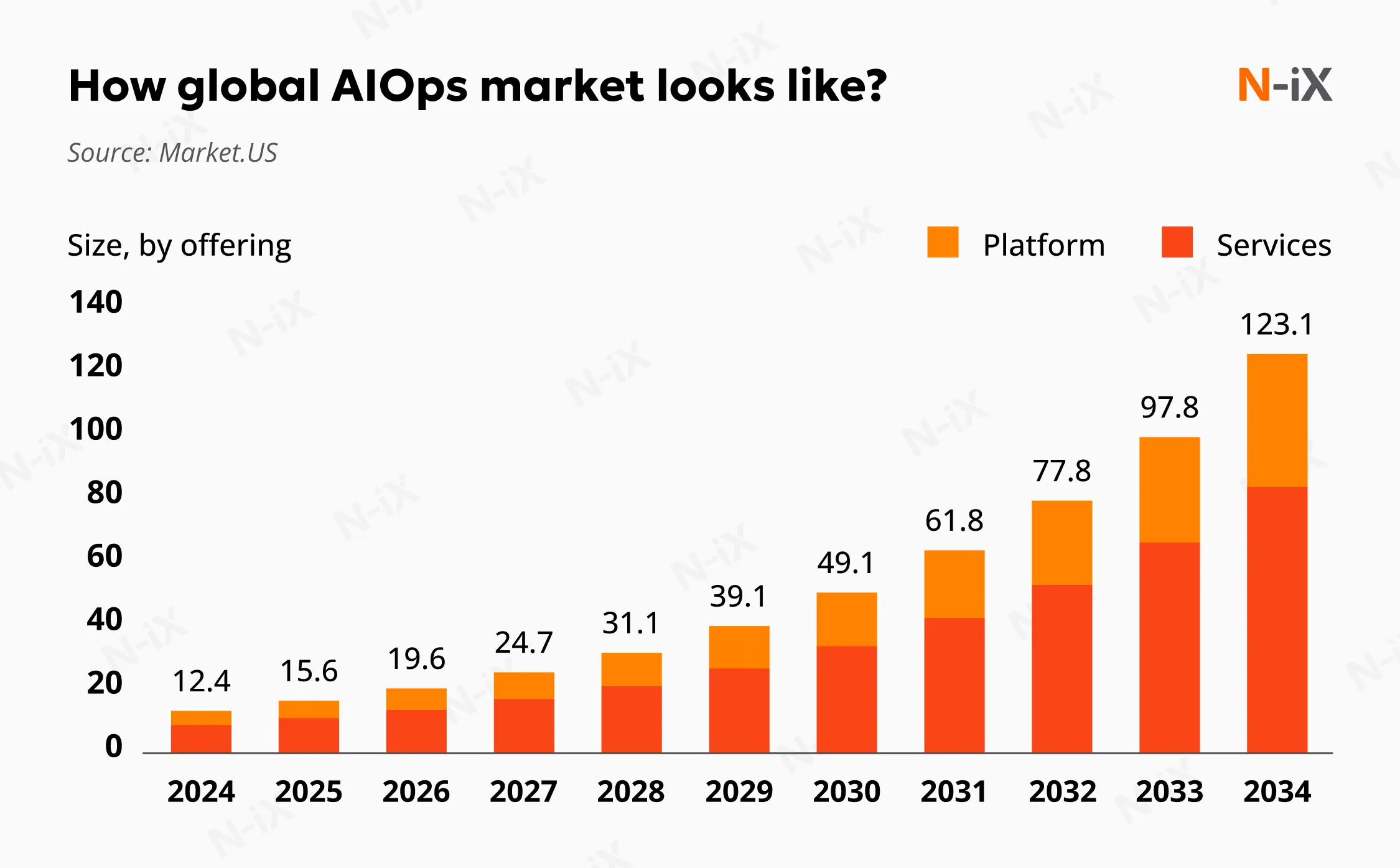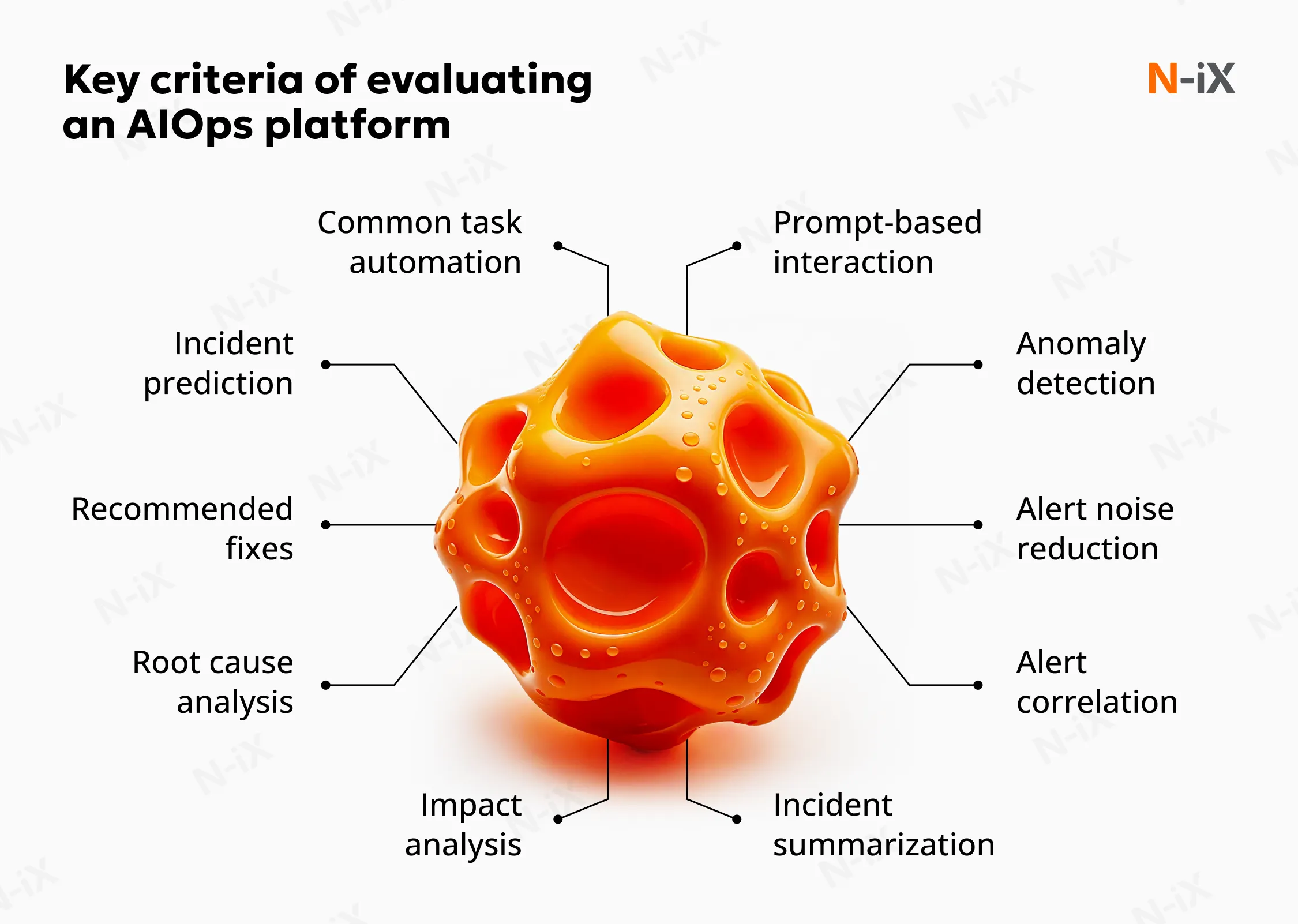As infrastructure grows more distributed, applications become more complex, and data volumes become more unpredictable, manual monitoring and rule-based automation are insufficient to ensure stability and performance. Applying Artificial Intelligence and Machine Learning to IT operations has led to the appearance of MLOps, LLMOps, and AIOps. The following is a methodological approach that relies on data science to streamline and facilitate systems resolution and solution delivery by enhancing many tasks and processes within IT workflows.
This article highlights the importance of Artificial Intelligence for IT Operations (AIOps) platforms. It explains how to choose an AIOps tool for enterprises by suggesting 10 criteria for assessing solutions, discovering common mistakes stakeholders make when picking an AIOps platform, and offering an AIOps tool evaluation checklist.
Why AIOps platforms are a strategic priority
Modern enterprise IT environments are operating at unprecedented levels of complexity and scale. Rapid adoption of cloud-native architectures, microservices, and hybrid infrastructure has dramatically increased operational data volume, velocity, and variety. Development and QA teams are constantly pressured to detect anomalies, diagnose incidents, and restore service before disruptions impact business continuity. Traditional DevOps toolchains and manual monitoring processes often struggle to keep pace in this environment.
Explore the AI landscape of 2026—get the guide with top trends!


Success!

Artificial Intelligence for IT Operations addresses this challenge by applying advanced analytics and Machine Learning to the full spectrum of IT operations. These platforms correlate data from diverse sources, provide end-to-end observability, and accelerate root cause analysis, enabling faster and more accurate problem resolution. They reduce reliance on manual intervention, streamline incident management, and allow IT teams to prioritize high-impact tasks over repetitive operational routines.
Beyond operational efficiency, AIOps platforms foster better collaboration across distributed teams by providing shared visibility into system health and performance. Enterprises can shorten mean time to resolution (MTTR) and improve service reliability and user experience. According to industry research, the AIOps market is projected to grow at a compound annual rate of 25.8%, nearly eightfold by 2025.

However, realizing the impact of AIOps depends on selecting a platform that aligns with an enterprise's specific infrastructure, workflows, and strategic objectives. The following sections outline the capabilities to prioritize, the evaluation criteria to apply, and the common pitfalls to avoid when choosing an AIOps tool.
Explore also key components and best practices for AIOps strategy
10 key criteria for evaluating an AIOps platform
Choosing an AIOps platform demands a structured evaluation of how each capability supports operational priorities, integrates with existing systems, and scales with future growth. Enterprises should assess the technical depth of a tool and how well it aligns with their incident management workflows, governance requirements, and broader IT strategy. The following AIOps tool selection criteria form a comprehensive framework for evaluating solutions.

1. Anomaly detection
The solution should identify unusual logs, metrics, traces, and other data patterns to enhance your response capabilities and reduce the mean time to detect (MTTD).
2. Alert noise reduction
Critical alerts that carry more weight should be clearly distinguished, while non-critical notifications should be deprioritized to minimize distractions and focus attention on events that matter most.
3. Alert correlation
Alerts related to a common event should be automatically grouped, removing redundancy and accelerating incident resolution.
4. Incident summarization
Summarized incident views help operations teams quickly assess severity, prioritize effectively, and respond to the most urgent cases without sifting through excessive detail.
5. Impact analysis
By applying methods such as Design of Experiments (DOE), the platform should reveal the scope and dependencies of an incident, identifying affected systems and services so that teams can concentrate on the most critical areas.
6. Root cause analysis
AIOps tools must flag issues and help pinpoint their origins, enabling operations teams to direct resources toward targeted remediation.
7. Recommended fixes
The platform should suggest context-specific solutions, learning from past incidents to refine recommendations and improve resolution efficiency.
8. Incident prediction
Leveraging historical data and trend analysis, the solution should anticipate recurring issues, allowing teams to address them before they cause disruption.
9. Common task automation
Routine tasks such as incident routing or standard troubleshooting steps should be automated to free up human resources for more complex problem-solving. The tool must also be scalable and adaptable to support evolving operational demands.
10. Prompt-based interaction
Natural Language Processing (NLP) capabilities enhance usability, enabling IT teams to query data and extract insights using conversational prompts rather than complex commands.
So, considering all these criteria, what are the practical steps to choose the right AIOps tool?
What is an AIOps evaluation checklist?
Selecting the right AIOps platform requires a structured approach that balances strategic alignment, technical suitability, cost efficiency, and operational readiness. Here is a step-by-step algorithm for how to choose an AIOps platform for your company's needs:
- Consider your business needs. Begin by clarifying the outcomes the platform must achieve. The selected tool should directly support organizational goals, meet industry-specific compliance requirements, and address defined use cases without introducing unnecessary complexity.
- Examine the solution's technical specifications. Examine whether the solution provides the functional depth required for your operational environment. It should be scalable and configurable to evolving needs, while integrating seamlessly with existing monitoring, ITSM, and DevOps toolchains.
- Assess associated costs beyond initial licensing or subscription fees, factor in deployment, integration, customization, ongoing maintenance, and staff training costs. Weigh these against the quantifiable operational gains to build a realistic ROI projection.
- Evaluate the vendor's expertise and reliability. A strong track record in delivering enterprise-grade AIOps solutions is critical. Review the vendor's experience within your sector, assess customer references and case studies, and examine their product roadmap to ensure alignment with your future requirements.
- Verify security and compliance readiness. Ensure the platform incorporates advanced security mechanisms for data protection, supports encryption in transit and at rest, and complies with all relevant regulations. Given AI's role in decision-making, assess the ethical safeguards, including bias detection, explainability, and transparency in automated actions.
- Train the team members. Technology adoption succeeds only when supported by the right skills. Provide structured training so IT and operations staff understand the platform's capabilities and the operational processes it will influence.
Now you understand how to choose an AIOps solution and what features to look for. The next step is to learn the common mistakes organizations make when adopting AIOps, and how to avoid them.
Common mistakes when selecting an AIOps solution
While AIOps adoption offers measurable advantages, implementing it in complex enterprise environments presents challenges. From our experience of providing AI consulting services for over two decades, we have seen how these obstacles, if left unaddressed, can slow deployment, reduce ROI, and limit the value of the investment. The following challenges reflect enterprises' most common issues and should be mitigated early in the selection and rollout process.
Overlooking existing infrastructure constraints
Legacy systems and custom-built applications may not integrate smoothly with advanced AIOps capabilities. Without a clear assessment of current architecture, compatibility issues can delay deployment and limit the tool's effectiveness.
Insufficient workforce readiness
Even the most sophisticated platform cannot deliver results without skilled personnel configuring, managing, and optimizing it. Teams must have a theoretical understanding and hands-on experience to leverage AIOps capabilities effectively.
Neglecting data quality requirements
AIOps performance depends heavily on the quality of the input data. Inconsistent, incomplete, or poorly structured data reduces the accuracy of anomaly detection, root cause analysis, and predictive capabilities.
Underestimating the ROI timeline
AIOps is a strategic investment that requires design, integration, and operational refinement before benefits are realized. Expecting immediate returns often leads to premature dissatisfaction and misaligned performance expectations.
Lack of enterprise-wide alignment
AIOps adoption affects multiple functions, from development and operations to business continuity planning. Without stakeholder engagement across departments, adoption can be slowed by resistance or misaligned priorities.
Final thoughts
AIOps is a priority for enterprises managing complex, distributed, and high-velocity IT environments. AIOps enables proactive issue detection, accelerated root cause analysis, reduced alert fatigue, and improved system reliability by applying advanced analytics, ML, and automation to IT operations. However, achieving these outcomes depends on more than adopting technology; it requires selecting a platform with the right capabilities, ensuring alignment with strategic objectives, and preparing teams to use it effectively.
Given the complexity of enterprise-scale deployments, partnering with a proven technology provider can significantly reduce implementation risks and accelerate value realization. With over two decades of experience in enterprise software development, data engineering, and AI development solutions, N-iX helps global organizations assess, select, and deploy AIOps platforms tailored to their operational and strategic needs.
Have a question?
Speak to an expert




